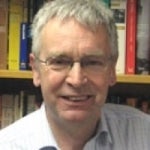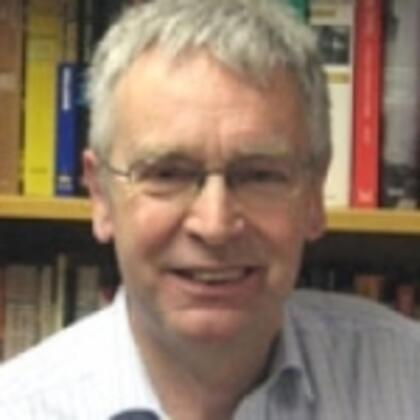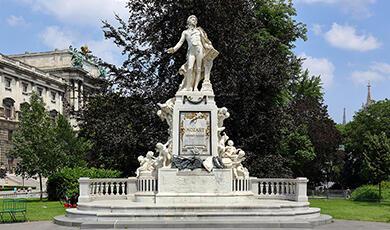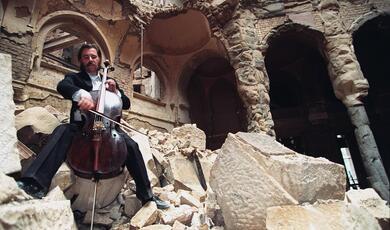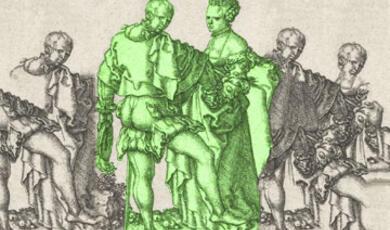Lutoslawski
Share
- Details
- Transcript
- Audio
- Downloads
- Extra Reading
Lutoslawski's Cello Concerto was commissioned by the Royal Philharmonic Society and premiered in London by Rostropovich in 1970. This lecture explores the compositional process and performance history through the sketches, concepts of musical drama, and the cultural and political contexts of time.
Download Transcript
Lutosławski's Cello Concerto
Professor Adrian Thomas
Introduction
In this, the fifth of this year's discussion of key works and composers of Central European music since the late 19th-century, I shall not only be exploring a landmark in music of the last 50 years. I shall also be outlining how a writer may set about the task of researching a book or topic. And my topic is the Cello Concerto (1969-70) by the Polish composer Witold Lutosławski (1913-94).
Preparatory Background
My interest in Lutosławski's music started with his Trois poemes d'Henri Michaux, for which I was one of the two conductors at the UK premiere in Nottingham in 1969. Ten years later, I heard Lutosławski conduct his Cello Concerto, with Heinrich Schiff as the soloist, at the Dublin Festival of Contemporary Music. Then, a couple of years ago, I entered into a contract with Ashgate Publishing to write a monograph as part of its new series, Landmarks in Music since 1950. Three of the volumes have already appeared: a study of Kurtag's The Sayings of Peter Bornemiszaby Rachel Beckles Willson, whom I had the pleasure of interview during last year's eries of Gresham lectures, a book on Andriessen's De Staat by Robert Adlington and a study of Shostakovich's Eighth String Quartet by David Fanning. I'm delighted that when we next meet I shall be discussing this quartet with David Fanning, partly as a prelude to its performance a couple of weeks later as part of the City of London Festival.
Lutosławski's Concept of Music Drama (1)
For many years I have regarded Lutosławski's Cello Concerto as a very special piece. Primarily this is because I think that he has succeeded in reconfiguring what a 'concerto' can be, in contemporary terms and with startlingly expressive results. This reconfiguration can be seen at many levels. Firstly, there is the question of structure. So this is perhaps the best moment to give you a brief overview of how the concerto unfolds, with short musical examples as I go along.
The standard concerto has three movements, with the dramatic weight of the piece occurring in the first movement, to be followed by a slow movement and a lively and often light-hearted finale. Lutosławski turns this idea on its head and adds a fourth movement at the start. And it is this movement - which Lutosławski called 'Introduction' - that is the most startling departure.
The Introduction is, for its first four minutes or so, for the soloist alone. The idea of beginning a concerto by the soloist rather than the orchestra is nothing new, of course. Among the examples from the literature we might cite the opening of Beethoven's Fourth Piano Concerto and the Second Piano Concertos by Saint-Saens' and Rachmaninov. Then there are the whip-crack starts of the openings of Grieg's Piano Concerto or Saint-Saens' First Cello Concerto. And Shostakovich's Second Cello Concerto provides us with another model, with its brief motif for solo cello before the orchestra becomes involved.
MUSIC Beethoven Fourth Piano Concerto/I (start)
Saint-Saens Second Piano Concerto/I (start)
Saint-Saens First Cello Concerto/1 (start)
Shostakovich Second Cello Concerto/I (start)
Closer to Lutosławski's approach is a work composed just seven years earlier, the Cello Concerto op.23 by the Soviet composer Boris Tischenko (b.1939). Here too the soloist has the stage metaphorically to himself for over four minutes. And while the style and content is very different from Lutosławski's, one cannot help wondering if the concept and initial focus on a particular pitch (in this case A natural) is coincidental. Could the score of Tischenko's Concerto have been among those that Rostropovich gave to Lutosławski when they met at the composer's flat in 1966?
MUSIC Tischenko Cello Concerto/I (start)
Lutosławski also opens his Cello Concerto with a repeated note, this time the lower, open-string D, before interpolating a series of what he called 'flights of fancy'.
MUSIC Lutosławski Cello Concerto (start)
When the solo cello seems to become stuck on the Ds, elaborating them with grace notes, there comes a violent interruption from the brass section. And this polarity between a meditative soloist and the brute force of that most warlike of instruments, the trumpet, sets up a conflict of one against the rest that informs the progress of the concerto to its very end.
MUSIC Lutosławski Cello Concerto/Fig.1
The second movement follows on when the cellist's D naturals have been reduced to silence. But it is the cellist who starts up first, attempting a series of dialogues with the woodwind, percussion and strings that takes the form of four Episodes. Each of these episodes is, however, ruthlessly put down by the brass.
MUSIC Lutosławski Cello Concerto/Fig.10 (first Episode)
The third movement, called by the composer a 'Cantilena', witnesses the solo cello seducing the strings into close cooperation, with the orchestral strings cushioning the soloist's expressive cantilena before joining it in a passionate unison that drives headlong to an inevitable collision with opposing forces.
MUSIC Lutosławski Cello Concerto/Figs.63 + 77 (Cantilena)
The Finale - not the first movement Introduction - is where the weight of the concerto lies and where the conflict between soloist and orchestra reaches its most dramatic narrative point. Here, for example, is the soloist answering the cataclysmic stamping of the orchestra with what appears to be a weeping submission which, moments later, is turned miraculously into a kind of 'resurrection' on high A naturals in the final moments of the concerto.
MUSIC Lutosławski Cello Concerto/Fig.133 to the end
There can be no doubting Lutosławski's direct sense of expression, the powerfulness of his concept of concerto genre.
Research Strategy
Let me backtrack a little from a discussion of the score itself and consider what a writer's research strategy might entail in a work such as this, by a composer working in Eastern Europe in the late 1960s, and which sources might further illuminate the creative process and circumstances of early performances.
As the author of a monograph on a single work, what do I need to do apart from musical analysis? Where do I find other research materials? The first port-of-call are secondary sources, in Polish and other languages, particularly for evidence of Lutosławski's own views. Secondly, as he deposited all his surviving compositional materials and correspondence at the Paul Sacher Foundation in Basel, visits to its archives were essential to be able to study the compositional process through his sketches and short score as well letters that he wrote or received before, during and after the months that he was working on the Concerto.
As far as recordings were concerned, I was anxious to garner as much information as possible since the premiere in London's Royal Festival Hall in October 1970. As we live, suddenly, in the age of internet search engines, then why not use the facility. I would not have discovered the Tischenko Concerto had I not been 'googling'. It was important early on to establish an accurate performance and recording chronology and to verify or dismiss claims for performances (see Appendix 1). Radio companies have been a crucial source. Surprisingly, I found it almost impossible to locate a recording of the premiere. In those days, if the BBC broadcast a performance live, it did not make a recording as well. So the BBC does not have a copy. Nor apparently does the South Bank, nor does the orchestra which gave the premiere under Edward Downes, the Bournemouth Symphony Orchestra. After much searching, I located a performance that had been given to Lutosławski. Polish Radio in Warsaw were able to let me hear recordings of early performances by Schiff (in Graz and in Warsaw, where he gave the Polish premiere in 1973) and, most interesting of all, Rostropovich's Russian premiere in Moscow in December 1972.
For the Concerto's reception history, Google apart, the British Library in Colindale was an excellent source for British, American and Polish newspapers from the early 1970s.
Along with my doctoral research student, Nicholas Reyland, I was privileged to have been allowed free access for several days in 2003 to Lutosławski's house in Warsaw. It has been left virtually untouched by his family since his death in February 1994 and that of his wife Danuta three months later. I was able, for example, to study his conducting score of the Cello Concero. It is much thumbed and sellotaped, and it includes some very helpful additional information. Our visit enabled us to see where he worked. This had a symbolic significance, because the Concerto was the first work which he completed after he moved into the house in 1968. Furthermore, though this has no bearing on our musical understanding, I discovered that his study had a fitted carpet - rather worn by 2003 - which Lutosławskii had ordered in London while he was here for the premiere. And where did he buy this carpet? Where else but in the late-lamented Gamages which used to stand not a hundred yards away from this hall. My guess is that, as his publishers were then not far from Farringdon Station, he was recommended to look in Gamages as it was so close by! It cost him a total sum, included postage and packing, of £ 81 7s. I came across this priceless information, alongside much more important documents, in the files of the Royal Philharmonic Society, which had commissioned the Concerto in 1966.
With this background sketch, and the sounds of the Cello Concerto still, I hope, ringing in your ears, I shall now look at four crucial aspects of my research on the work: the commissioning process, the compositional process, a more detailed look at his concept of drama in music, and the Concerto's cultural and political contexts.
The Commissioning Process
By the composer's published account, he was contacted by his publisher in 1968, while he was teaching at a summer school in Denmark, to say that he'd been approached by the Royal Philharmonic Society in London. This is not supported by the RPS files, which indicate that the Society contacted Lutosławski directly in October 1966. In fact, a commission to Lutosławski was not the original idea. The RPS had asked Richard Rodney Bennett, who had had to withdraw. When the RPS turned to Lutosławski, it was asking a non-British composer for the first time since regular commissions had been placed after the Second World War.
Lutosławski responded quickly and eagerly to the request (which came with a fee, supported by the Gulbenkian Foundation, of £ 500), but in a sequence of letters over the next eight months he pushed the proposed performance date back from the 1967-68 season to 1969-70 (in the end, it took place at the start of the 1970-71 season). The first clue as to his intentions regarding the kind of piece that he wanted to write came in a letter of 10 June 1967:
I should be very grateful if you would consider the possibility of commissioning me to write a work for orchestra with soloist (voice or instrument or group of instruments) instead of a purely orchestral work. The reason for this my question is, that two last commissions I have been working on are just large-scale orchestral works [Symphony 2 and Livre pour orchestre]. On the other hand I have never composed any large-scale piece for symphony orchestra with soloist and I should very much like to do this some day.
The RPS agreed, leaving the choice of instrument up to the composer. Only in October 1967, a year after the first approach from the RPS, did the head of Lutosławski's publishers in London, Chester Music, learn of the plan: "I spoke to the Secretary of the Royal Philharmonic Society and am delighted to hear that you are to be commissioned to compose an orchestral work for 1970. This is most exciting …". And it was another year (1 November 1968) before the name of Rostropovich and mention of a Cello Concerto was noted in the RPS minutes. The whole process, therefore, was taken at a leisurely pace, with no initially clear idea of what might emerge.
If we wind forward to early 1970, when Lutosławski was concentrating solely on the new Concerto, it becomes clear that he was so concentrated that he was neglecting to keep others up-to-date with his progress, as his publisher complained on 2 February: "| had a telephone call the other day from Rostropovitch's [sic] agent, making rather anxious noises. Have you any news for me or him?". Six weeks later Lutosławski replied:
"I have been so intirely [sic] preoccupied with the completing three parts of my Cello Concerto (the fourth is still in progress) in order to send it off to Rostropovich, that it has been impossible for me to do anything else. Now I am ready to let him have the great part of my work and he will receive the score the next week. The title is simply Concerto (for cello and orchestra), the orchestration - the standard symphony orchestra (3,3,3,3 - 4,3,3,1 - 3 percussion players - celesta, harp, piano, strings). I am afraid I have no notion of the duration as long as I have not finished the final part. The work is in principle in one single movement but four parts will be easily to distinguish: Introduction, four Episodes, "Cantilena" and Finale."
Finally, on 27 July 1970, Lutosławski was able to reply to his publisher:
"I am sorry being so late with the answer to your letter … I have been completing the Cello Concerto which is ready, I finished the last page this afternoon. The approximate duration is 24 minutes. … She [his wife, Danuta] has now tremendous work to do with the parts of the Concerto. … I will write the programme note about the Cello Concerto myself. It will probably consist of some excerpts of a letter I am preparing to send to Rostropovich, explaining different aspects of the piece."
What was Lutosławski's compositional process? He had a familiar routine, in which the mornings were devoted solely to sketching and composing. From the materials for this work and others, now available for study at the Paul Sacher Foundation, there appears to be a fairly straightforward sequence in the process even though sketches are dated only rarely and therefore the exact sequence of events is often a case of surmise. In the Cello Concerto, he appears to have begun with a fairly lengthy verbal description of his intentions and aspirations (in other works, graphic diagrams were to the fore). His original concept for the Cantilena, for example, outlined its stages in vivid descriptions: "devoutly - sensually - pompously [patetycznie, akin to the French pathétique ] - with exultation - ecstatically". He often sketched rhythmic and pitch schemes separately before bringing them together. Once most of the sketch pages (habitually in A5 landscape format) had been assembled, Lutosławski proceeded to write out the short score, i.e. a score on two or three staves in which instrumentation was indicated for implementation on the full score. The short score of the Cello Concerto is remarkably close to the final version, although towards the end its detail and neatness becomes inconsistent as the composer hurries forward. The full score, as was more or less usual, is in the hand of his wife Danuta.
Concept of Music Drama (2)
You have already sampled the overall dramatic shape of the Cello Concerto, so here I shall focus on one tiny but significant detail. In his precompositional description of the piece, Lutosławski described the Introduction as consisting of "various frolics - carefree - small cantilenas - coquettish - dancing gambols". Is this what he had in mind?
MUSIC Lutosławski Cello Concerto/after initial D naturals
Lutosławski described the several such ideas that populate the Introduction thus: "each intervention must have its own physiognomy". This epithet occurs on what appears to be one of, if not the first sketch of the work. As you can see, he has two attempts at the opening gesture (groups of semiquavers in a generally rising direction). He has crossed out the first one, then inserted above an idea followed by three exclamation marks, as if exclaiming 'Eureka!'. This little idea is what has come to symbolise this Concerto, the regular repetition of a single note. When he came to do the pitch design, this note turned out to be the open-string D natural. And one may even characterise this Introduction as being a fantasia on one note, so crucial is its significance.
Let's look at how it is defined. There's a single pitch, a single pulse, a single dynamic, a single articulation, a single performance instructionindifferente (faceless? disengaged?). In the same way that there are precedents for starting a concerto with the soloist alone, so there are precedents for beginning a work with a repeating single-note pulse. Think of Beethoven's Violin Concerto, Brahms' First Symphony, Britten'sSinfonia da Requiem, Lutosławski's own Concerto for Orchestra (there are further ties between these last three, but that is a topic for another occasion). And it is surely significant too that the single articulation is not alternating down and up bows (that would be absent-minded, to borrow Lutosławski's own description) but repeated down-bows, which bespeak a degree of determination, therefore consciousness.
Where does the performer come into this? Playing this note D in the way set out by the composer is no easy task. He is asking for total lack of expression, total evenness. From my discussions with players who worked with him, it appears that he rarely offered advice, and it is clear from the recordings which he himself conducted that he gave a great deal of leeway to the soloist who is the dominant figure in this narrative, from the extraordinary extended monologue at the beginning to his shifting rapprochements with and rebuttals by the orchestra. In this Introduction, for example, it was the work's dedicatee, Rostropovich, who took the greatest liberties, both at the premiere in London and at the Russian premiere in Moscow in December 1972. In Moscow, he plays fast and loose with the number of repetitions of the D naturals (25 on the first appearance, not 15-20 as indicated) and has seemingly no intention of controlling the sound of the Ds - their dynamics and tone quality are very variable.
MUSIC Lutosławski Cello Concerto/start (Rostropovich in Moscow)
If one looks at the tempo of the D naturals, Lutosławski has gone to great trouble to delineate his idea of one beat per second (a fairly common idea in the 1960s and 70s). He has actually divided it into 5 units, a semiquaver D followed by a crotchet rest (cf. the start of his String Quartet, 1964). And although he has requested circa 60, it is fascinating to see that all but one of the recorded performances are slower than this marking. Miklos Perenyi even drops to 40 pulses per second, while at the Polish premiere in 1973 Schiff decelerates in ensuing returns to the D natural idea.
MUSIC Lutosławski Cello Concerto/start (Perenyi)
LutosławskiCello Concerto/start (Schiff in Warsaw)
More recent recordings, such as that by Peter Wispelwey, take a more considered line towards meticulousness and impassivity with the D naturals, thus approaching Lutosławski's intentions much more closely.
MUSIC Lutosławski Cello Concerto/I (Wispelwey)
Another measure of differing performances is to consider the overall timings and those of the four main sections, taking the process further by looking at the prcentage balance between them. Overall timing range widely, from 22 to 27 minutes, when Lutosławski's guide duration is 24 minutes. It comes as a bit of a surprise to find that Rostropovich privileges the Introduction over the expressive Cantilena, but he is in a rush to engage in the conflict of the Finale. Schiff and his pupil do the opposite.
Earlier I mentioned Lutosławski's fondness for descriptors. Occasionally he divulged some ideas to his soloists. To Heinrich Schiff, for example, he described the Introduction as 'paradisiac' and 'idyllic' (not adjectives one would associate with Rostropovich's intense interpretations). He also gave a clue to the significance of a dramatic moment from the Finale when the soloist answers the thundering tutti at fig.88.
MUSIC Lutosławski Cello Concerto/IV, fig.86-90
In a conversation with Heinrich Schiff which I had eighteen months ago, he recounted Lutosławski's sotto voce words spoken in a public place:
… here, the Individuum says, "Yes, you are strong, I know that, there's no question of it, physically anyway, you are stronger, but, let's let's see, how things develop, maybe the last word is not spoken."
Cultural and Political Contexts
And this comment brings me to my final section today: the cultural and political contexts of art. In this case study, such contexts are evident and pertinent. For example, the year 1968, known to most of us as a year of riots in Paris, Kent State University in the USA, the Prague 'Spring', was also the occasion in Poland for the banning of a revered Polish play, a banning that led to mass student unrest in Warsaw and a government-inspired anti-semitic drive. This was when Lutosławskiwas thinking about his forthcoming concerto. The immediate context of the premiere of Lutosławski's Cello Concerto, which, to remind you, took place here in London on 14 October 1970, is fascinating.
Six days earlier, the Russian dissident Aleksander Solzhenitsyn was awarded the Nobel Prize for Literature. The next day, The Times reported: "Mr Solzhenitsyn's present whereabouts is not generally known. He was last rumoured to be enjoying the hospitality of Mr Mstislav Rostropovich, the cellist, near Moscow." So Rostropovich's intimate involvement with Solzhenitsyn's fate was suddenly thrust into the Western limelight. On 12 October, TheDaily Telegraph reported: "He [Solzhenitsyn] is living in a garage apartment belonging to Mstislav Rostropovich, the cellist, who arrived in London yesterday to receive the Philharmonic Society's Gold Medal." No mention of Lutosławski, then - the internationally celebrated virtuoso was more noteworthy than the far less well-known Polish composer. On the day of the premiere itself, coincidentally, there was a further reminder of the Cold War and its atmosphere of suspicion and espionage. The Times ran an obituary for Gordon Lonsdale, 'Russian mastermind of Portland spy ring', who had been sentenced in 1961 for 25 years only to be exchanged three years later in Berlin for the British businessman, Greville Wynne. Such were the swirling politics surrounding the Royal Philharmonic Society concert.
The RPS Chairman was not unaware of the pressures on Rostropovich. As the minutes of 21 September ran, three weeks prior to the premiere:
in view of recent events in connection with the Russian Ballerina [Natalia Makarova had defected from the Kirov Ballet in the RFH couple of weeks earlier], there had at one time been some doubt about the appearance of Rostropovich. Mr. Foggin reported that he had been told by the Ministry of Education and Science that there was now a possibility that the Soviet Cultural Minister would come to London for the concert, and he therefore felt reassured that all was well. Mr. Foggin said that Lord Eccles had been made aware of the situation and would, of course, give the final word on the Government's attitude.
And yet the reception of the Cello Concerto indicates that the critics did not make any real connection between the Concerto's premiere and current events in the home countries of either the soloist or the composer. Two years later, when Rostropovich gave the Soviet premiere, the response was much more attuned to programmatic interpretation. There were no newspaper reviews, but the American journalist, Hedrick Smith, noted down the reactions of his friends who attended the concert:
So prone are Russians to read significance into every art form that they can find political overtures even in musical performances. In December 1972, Mstislav Rostropovich was under a ban against foreign travel and was severely restricted in his home concerts. … One highlight was his performance of a new composition by Poland's leading composer, Witold Lutosławski, …
Russian friends of mine who saw the performance interpreted it as more than the bold airing of provocatively modern music. They saw it as a deliberate statement of the cellist's and the composer's philosophy. In several passages the lone lyrical voice of Rostropovich's cello struggled to be heard against a crashing and cacophonous orchestra. To Rostropovich's friends and enthusiasts, the message was that of a free and unbowed musical and intellectual spirit struggling to make himself heard against the din of cultural orthodoxy and in spite of offficial censure of his behaviour. 1
Without doubt, Rostropovich saw his role and that of his instrument in the Cello Concerto as that of the solitary human battling against the evil forces of an oppressive state. There is, however, no evidence beyond the type of rare anecdote which I cited earlier that Lutosławski either conceived of his Cello Concerto as being deliberately programmatic in this sense or of his being in any way content with such an interpretation. Indeed, when confronted by Polish critics with this idea in their mind (especially regarding the Finale), Lutosławski felt compelled to issue admonitions and to stress the 'purely musical drama' of the work.
My own interpretation of this situation, for what it is worth, is that Lutosławski was torn between those private compositional thoughts, some programmatic, that lay behind the work, and the effect of the resulting music on his listeners. He was content to point out the connection between his music and the drama of the theatre, but increasingly loathed any extra-musical political interpretation. A last illustration of this dilemma concerns the Coda. In his sketches, Lutosławski had written of the Coda as a kind of 'angelic triumph', implying a transition from earth to heaven from death to eternal life. Am I overinterpreting?! Heinrich Schiff told me of how Lutosławski and Rostropovich had discussed the Coda:
He [ Lutosławski ] told me the story that Rostropovich always said "Yeah, but that means that the cello at the end is winning". [Schiff, soft-voiced, imitated Lutosławski's response] "No, no, no, you can't say that." Lutosławski then said, "I told to Slava, I said, OK, the cello has its victory, but in a different world".
Perhaps part of Lutosławski's solution was to view the drama as being otherworldly, abstract, but allowing others to relate its drama to their own worldly experience. Whichever way you and I hear this Concerto, its lasting impact through ever more recordings continues to exercise its power to move listeners. And no composer can ask for more.
1 Hedrick Smith, The Russians (New York, 1976)
Appendix 1
Witold Lutosławski's Cello Concerto was commissioned by the Royal Philharmonic Society in London and was premiered on 14 October 1970 in the Royal Festival Hall by Mstislav Rostropovich, with the Bournemouth Symphony Orchestra conducted by Edward Downes. At the same concert, Rostropovich received the RPS Gold Medal.
Early Performances
1970
14.10.70 LondonRostropovich/Bournemouth SO/Downes
(+ 15.10 Bournemouth, 16.10 Exeter)
1971
9.12.71 Copenhagen Erling Blöndal Bengtsson/Danish RSO/Blomstedt
1972
13.01.72 Minneapolis Rostropovich/Minnesota SO/Skrowaczewski
11.02.72 Hannover Siegfried Palm/Hannover NDRO/Lehel
17.10.72 Graz Heinrich Schiff/Ljubliana R&TVSO/Hubad (ISCM)
13.12.72 Moscow Rostropovich/USSR R&TVSO/Rozhdestvensky
21.12.72 Utrecht Palm/Utrecht SO/Hupperts
1973
.....01-73 Poland Radio broadcast on PR3 of Moscow performance
.....01-73 Poland [a day later] Radio broadcast on PR2 of Graz
performance
23.02.73 Bucharest Schiff /George Enescu Bucharest PO/WL
9.03.73 Bor Rostropovich/Gorky PSO/Gusman
(+ 10,11.03 Gorky, 12.03 Djerzhynsk)
early 04.73 Basel Schiff/Basel SO/Hubad
30.09.73 Warsaw Schiff/National PO/WL ('Warsaw Autumn' Festival)
15?.11.73 West Berlin Wolfgang Boettcher/Berlin PO/Krenz
30.11.73 Vienna Schiff/Vienna SO/WL
20.12.73 Düsseldorf Palm/Düsseldorf SO/WL
Commercial Recordings
1974 Paris Rostropovich/Orchestre de Paris/WL
1975 Budapest (?) Perényi/Hungarian R&TVSO/Lehel
1976 Katowice Jabłoński /WOSPR/WL
1986 Munich Schiff/Bavarian RSO/WL
1989 London Hopkins/Guildhall SO/WL
1995 Katowice Bauer/PRNSO/Wit
1997 Katowice Strahl/Silesian State PSO/Swoboda
1997 Warsaw Bauer/National PO/Krenz ('Warsaw Autumn' Festival)
1998 Stockholm Thedéen/Swedish RSO/Segerstam
1998 Hilversum Wispelwey/Netherlands RP/Steen
1999 Stuttgart Weinmeister/Stuttgart SWRSO/Schiff
© Professor Adrian Thomas, Gresham College, 17 March 2005
This event was on Thu, 17 Mar 2005
Support Gresham
Gresham College has offered an outstanding education to the public free of charge for over 400 years. Today, Gresham plays an important role in fostering a love of learning and a greater understanding of ourselves and the world around us. Your donation will help to widen our reach and to broaden our audience, allowing more people to benefit from a high-quality education from some of the brightest minds.


 Login
Login
